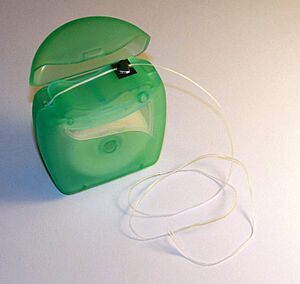Dental floss facts for kids
Dental floss is a special type of string or thread. You use it to clean the tiny spaces between your teeth. These spots are often too small for your toothbrush bristles to reach. It's really important to floss at least once every day. Many dentists suggest flossing before you brush your teeth.
Brushing alone cannot remove all the food stuck between your teeth. When food gets packed in these spaces, it can cause problems. Tiny living things called Bacteria love to grow in this trapped food. These bacteria can make the surface of your teeth, called enamel, start to break down. This can lead to unhealthy teeth and gums. Sometimes, even your jawbone can get sick.
The bacteria from food on and between your teeth form a sticky film. This film is called "plaque." Plaque can make your gums less healthy. One common gum problem is "Gingivitis." This means your gums might become red, swollen, or bleed easily. Flossing helps a lot to stop gingivitis. If plaque is not removed, very serious diseases can start. These diseases can even damage your jawbone badly. These hard-to-treat jawbone diseases are called "periodontal disease." Flossing your teeth helps protect you from these serious problems.
Contents
Why Flossing is Super Important
Flossing is a key part of keeping your mouth healthy. It helps prevent many problems that can affect your teeth and gums.
Fighting Plaque and Bacteria
Plaque is a sticky film of bacteria that constantly forms on your teeth. These bacteria feed on food particles left in your mouth. As they eat, they produce acids. These acids can wear away your tooth enamel. This can lead to cavities. Flossing helps remove plaque from between your teeth. This is where your toothbrush often misses.
Protecting Your Gums and Jaw
When plaque builds up, especially near your gums, it can cause gum disease. Gingivitis is the first stage of gum disease. Your gums might look red or swollen. They might even bleed when you brush or floss. If gingivitis is not treated, it can get worse. It can turn into periodontal disease. This serious condition can damage the bone that holds your teeth in place. Flossing regularly helps keep your gums healthy and strong. It also protects your jawbone.
Saying Goodbye to Trapped Food
Sometimes, food gets stuck between your teeth. This can feel uncomfortable or even cause pain. Foods like meat or apples can be quite fibrous. They often get wedged tightly in those small spaces. When hard food is pressed against your gum, it can hurt. Some people try to use toothpicks to remove trapped food. Others use dental floss.
Floss vs. Toothpicks: The Winner Is...
Dental floss can do most things a toothpick can do. But floss is much thinner. This means it can reach places that most toothpicks cannot. So, floss is usually better at getting tiny bits of food out. It can relieve discomfort and pain more quickly. Flossing also cleans the sides of your teeth. Toothpicks mostly just poke at the food.
What to Expect When You Start Flossing
When you first start flossing, your gums might bleed a little. This can happen if your teeth and gums are not very healthy yet. It is a normal reaction. Don't worry, this bleeding usually stops as your teeth and gums get healthier. Just keep flossing every day. Soon, your gums will become stronger and healthier.
Images for kids
See also
 In Spanish: Hilo dental para niños
In Spanish: Hilo dental para niños





